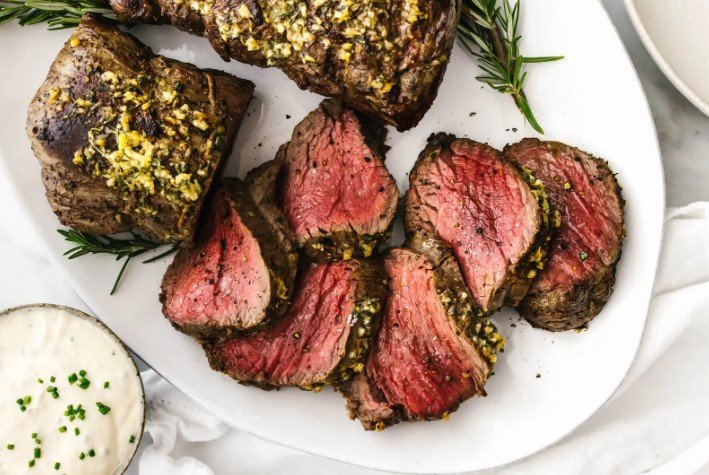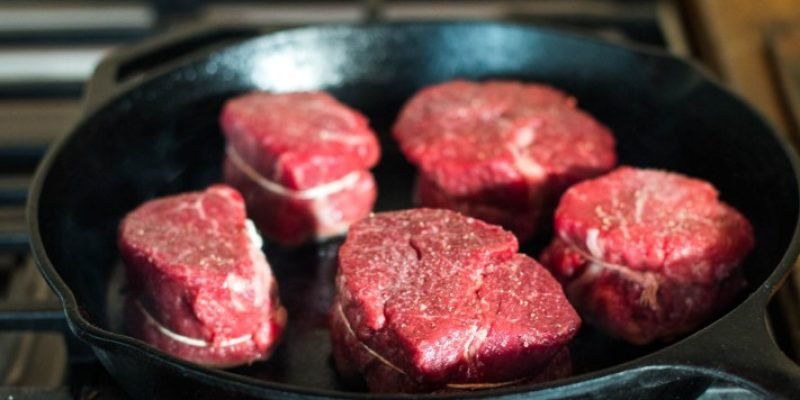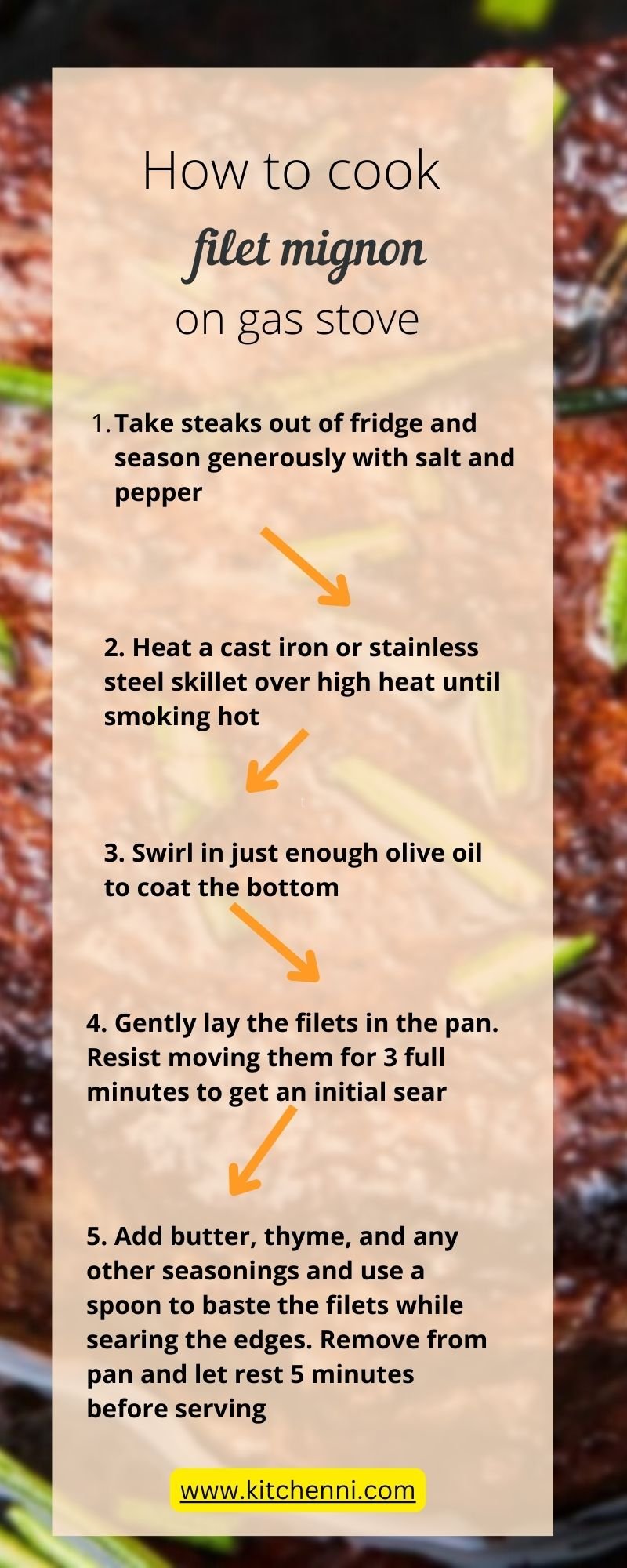When only the tenderest, juiciest cut of beef will do, filet mignon steaks are perfect dining option. But contrary to popular belief, you absolutely can cook these fancy steaks on your own gas stove at home.
Sure, you may not quite replicate the 1800°F broiler of a commercial kitchen. But with a bit of technique and a searing hot skillet, I guarantee you can pull off impressively flavorful fillets without even leaving the house.
Grab your tongs and let me walk you through every step of the process, from picking the perfect filets to bringing out that gourmet flavor. I’ve got pro tips to help you nail tender, juicy steaks worthy of the finest steakhouse every time.
But first….let’s cook
How to cook filet mignon on gas stove – Simple Recipe Infographic
What You Need – Ingredients
To serve two fancy steakhouse-worthy filet mignon dinners at home, you’ll need:
- 2 filet mignon steaks, cut 1.5-2 inches thick
- Kosher salt and coarsely ground black pepper
- 2 tablespoons olive oil
- 2 tablespoons butter
- 2 sprigs fresh thyme (optional)
- Extra seasoning options: garlic, rosemary, Montreal steak spice
That’s it – with quality thickly cut filets and just a few basics, you have everything you need for an incredible steak meal. Now let’s go over the cooking method.
Directions
Follow these steps for flawlessly seared filets:
- Take steaks out of the fridge and season generously with salt and pepper.
- Heat a cast iron or stainless steel skillet over high heat until smoking hot.
- Swirl in just enough olive oil to coat the bottom.
- Gently lay the filets in the pan. Resist moving them for 3 full minutes to get an initial sear.
- Flip steaks and sear for another 2 minutes for medium-rare doneness.
- Add butter, thyme, and any other seasonings, and use a spoon to baste the filets while searing the edges.
- Remove from pan and let rest 5 minutes before serving.
Tips – Please Note
Going overboard on heat leaves you with a tough, dried-out hockey puck. The keys are a ripping hot pan, frequent flipping, and resisting the urge to overcook.
Here are some quick tips to keep in mind:
- Let steaks sit at room temperature 30 minutes before cooking for more even cooking.
- Pat steaks dry thoroughly with paper towels before searing to help with browning.
- Use tongs instead of a fork to flip to avoid piercing and losing juices.
- Add garlic cloves or herb sprigs to pan while basting to boost flavor.
- Resist cutting into steaks before they rest to allow juices to redistribute.
Here is a draft article on picking the perfect beef filets for cooking:
How to Pick the Best Beef Tenderloin for Cooking

I promised you at the beginning to give you some handy tips to help you choose the best beef tenderloin for cooking at home.
Well, here we go……
1. Check the Shape
When raw, an ideal beef tenderloin should look evenly thick and cylindrical in shape. Avoid filets that appear misshapen, excessively narrow at one end, or irregularly textured. Uniformity of shape helps the tenderloin cook evenly.
2. Seek Out Marbling
Look for thin lines of fat marbled throughout the tenderloin. Some marbling provides flavor and moisture when cooking. Too much marbling can result in a greasy texture. Choose a balance between minimal and moderate marbling.
3. Inspect the Color
Raw tenderloin should be a bright reddish-pink color all over. The lean cut should not appear too dark or dried out. Check that the color is consistent across the entire surface. Discoloration can be a sign of improper storage or handling.
4. Feel for Firmness
When raw, tenderloin should feel firm to the touch, not mushy or overly soft. Gently prod the meat and make sure it springs back, which indicates freshness. The firmer the raw tenderloin, the more tender it will be after cooking.
5. Consider the Size
Standard tenderloin filets are around 2-3 lbs. Size impacts cooking time, so plan accordingly. Larger filets may need to be seared and finished in the oven. Smaller filets under a pound are ideal for quicker stovetop cooking.
6. Inspect the Packaging
Always choose fresh filets that are bright red and packaged properly. Vacuum-sealed is best. Avoid filets in ripped, stained, or open packaging that may indicate spoilage. Check the sell-by date and pick the package furthest from expiration.
Bottom Line
While loved for tenderness, filet mignon does require special handling to cook properly and not end up disappointingly dry. With the right prep, seasoning, and searing over high heat, your gas stove has all it takes to achieve juicy, buttery filets worthy of your favorite steakhouse.
Common Questions
What is the best thickness for filet mignon?
Look for 1.5-2-inch thick filets. This allows you to get a nice sear while keeping the inside tender and pink. Thinner cuts will overcook too quickly.
What temperature should I cook filet mignon to?
For medium rare doneness, pull the filets from the pan at 135°F internal temperature. This prevents overcooking. Let rest for 5 minutes, then enjoy!
Can I grill filet mignon instead?
Yes, you can certainly grill filets on a hot clean grill instead of pan-searing. Use high direct heat and flip frequently for the same medium rare effect.
What sides go well with filet mignon?
Common pairings are roasted Marshmallows, potatoes, grilled asparagus, sautéed mushrooms, creamed spinach, and macaroni and cheese.
Is filet mignon supposed to be tender?
Yes, the tenderloin muscle gets little use, so filet mignon is prized for its buttery smooth texture. Cooking properly preserves this tender quality.

